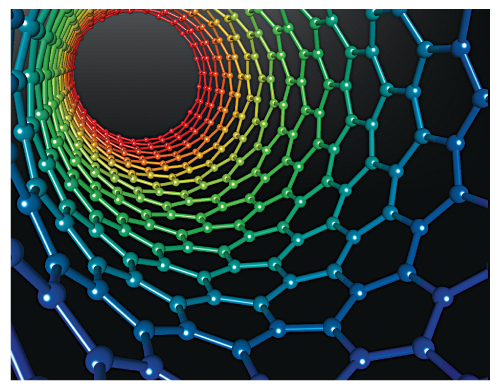In nanotechnology, a particle is defined as a small object that is a complete unit in terms of its transport and properties. Nanoparticles effectively act as a bridge between bulk materials and atomic or molecular structures. Properties of materials become significant at nanoscale (as the percentage of atoms) towards the surface of the material.

A carbon nanotube (CNT) structure is a sheet of graphite (a hexagonal lattice of carbon) that is rolled up to form tubes. CNTs are promising candidates as field emitters because of their sharp geometry, mechanical strength, chemical stability and electrical conductivity.
The diameter of single-walled CNTs can be as small as 0.4 nm. However, typically, the diameter ranges between 0.7 and 3 nm with mean diameter at 1.7 nm. Nanotubes have a high thermal conductivity of about 2000W/m/K, which is several times higher than copper’s 400W/m/K. Being one dimensional, CNTs reduce the probability of scattering.
Ballistic transport
Nanotubes are inert and have no surface states, which make them very compatible with other materials. As a result, the device may operate in ballistic regime. The nanotube conducts essentially on its surface where all the chemical bonds are saturated and stable. In other words, there are no dangling bonds that form interface states. All chemical bonds of the ‘C’ atoms are satisfied and there is no need for chemical passivation of dangling bonds as in silicon.
The defect and failure rates at device and circuit levels are expected to be much higher than with traditional CMOS. Perfect CNTs have all carbons bonded in a hexagonal lattice except at their ends, whereas defects in mass-produced CNTs introduce pentagons, heptagons and other imperfections in the sidewalls that generally degrade desired properties.
The perfect structure of the CNTs allows them to transport electrical charge without scattering over several micrometres. This property is termed as ballistic transport. Ballistic transport is basically the smooth traverse of electrons in a medium without encountering a scattering event. Ideally, it is observed when the medium length is smaller than the mean free path of the scattering length. Correspondingly, power dissipation is low. The electrostatic behaviour of CNTs is different from that of silicon devices with implications on screening and electron/hole tunnelling.
Electronic, molecular and structural properties of carbon nanotubes are determined to a large extent by their nearly one-dimensional (1D) structure. Carrier transport is 1D. This implies a reduced phase space for scattering of the carriers and opens up the possibility of ballistic transport. The 1D confinement of electrons allows motion in only two directions. This constraint along with the requirements for energy and momentum conservation dramatically reduces the phase space for scattering processes. The equilibrium band profile and charge density are obtained by solving the Poisson equation in cylindrical coordinates self-consistently with the equilibrium carrier statistics of the CNT.
Resistivity originates from either the scattering of impurity atoms, lattice vibration of atoms (which are called acoustic and optical phonons), crystal defects in the medium or interfaces. These scattering sources tend to slow down the velocity of traverse electrons.
Nanotubes have a very broad range of electronic, thermal and structural properties that change depending on the different kinds of nanotube (defined by its diameter, length and chirality, or twist). The differences in conducting properties are caused by the molecular structure that results in a different band structure and thus a different band gap.







